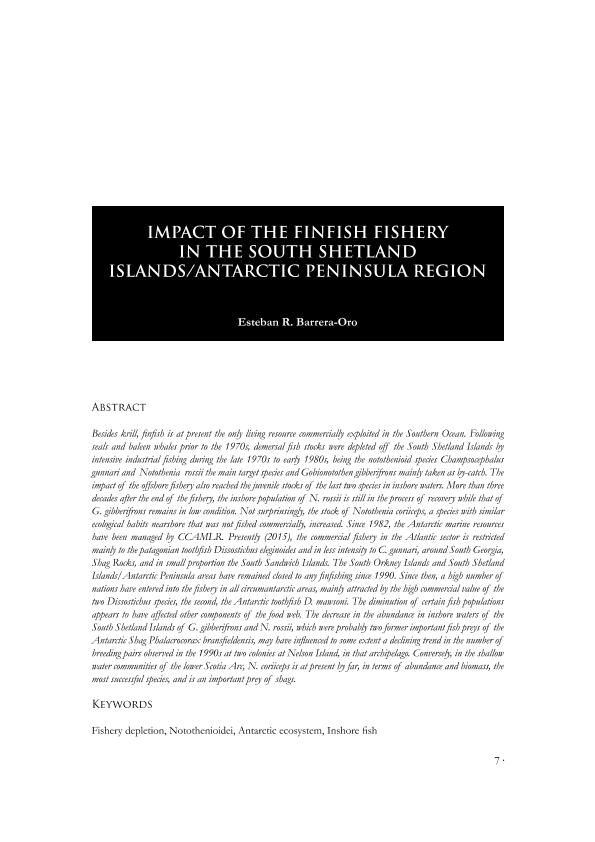Mostrar el registro sencillo del ítem
dc.contributor.author
Barrera Oro, Esteban

dc.date.available
2018-10-19T14:20:06Z
dc.date.issued
2015-09
dc.identifier.citation
Barrera Oro, Esteban; Impact of the finfish fishery in the South Shetland Islands/Antarctic Peninsula region; Agenda Antártica; Journal of Antarctic Affairs; II; 9-2015; 7-19
dc.identifier.issn
2451-7755
dc.identifier.uri
http://hdl.handle.net/11336/62763
dc.description.abstract
Besides krill, finfish is at present the only living resource commercially exploited in the Southern Ocean. Following seals and baleen whales prior to the 1970s, demersal fish stocks were depleted off the South Shetland Islands byintensive industrial fishing during the late 1970s to early 1980s, being the notothenioid species Champsocephalus gunnari and Notothenia rossii the main target species and Gobionotothen gibberifrons mainly taken as by-catch. Theimpact of the offshore fishery also reached the juvenile stocks of the last two species in inshore waters. More than three decades after the end of the fishery, the inshore population of N. rossii is still in the process of recovery while that of G. gibberifrons remains in low condition. Not surprinsingly, the stock of Notothenia coriiceps, a species with similar ecological habits nearshore that was not fished commercially, increased. Since 1982, the Antarctic marine resources have been managed by CCAMLR. Presently (2015), the commercial fishery in the Atlantic sector is restricted mainly to the patagonian toothfish Dissostichus eleginoides and in less intensity to C. gunnari, around South Georgia, Shag Rocks, and in small proportion the South Sandwich Islands. The South Orkney Islands and South Shetland Islands/Antarctic Peninsula areas have remained closed to any finfishing since 1990. Since then, a high number of nations have entered into the fishery in all circumantarctic areas, mainly attracted by the high commercial value of the two Dissostichus species, the second, the Antarctic toothfish D. mawsoni. The diminution of certain fish populations appears to have affected other components of the food web. The decrease in the abundance in inshore waters of the South Shetland Islands of G. gibberifrons and N. rossii, which were probably two former important fish preys of the Antarctic Shag Phalacrocorax bransfieldensis, may have influenced to some extent a declining trend in the number of breeding pairs observed in the 1990s at two colonies at Nelson Island, in that archipelago. Conversely, in the shallow water communities of the lower Scotia Arc, N. coriiceps is at present by far, in terms of abundance and biomass, the most successful species, and is an important prey of shags.
dc.format
application/pdf
dc.language.iso
eng
dc.publisher
Agenda Antártica
dc.rights
info:eu-repo/semantics/openAccess
dc.rights.uri
https://creativecommons.org/licenses/by-nc-sa/2.5/ar/
dc.subject
Fishery Depletion
dc.subject
Notothenioidei
dc.subject
Antarctic Ecosystem
dc.subject
Inshore Fish
dc.subject.classification
Otras Ciencias Biológicas

dc.subject.classification
Ciencias Biológicas

dc.subject.classification
CIENCIAS NATURALES Y EXACTAS

dc.title
Impact of the finfish fishery in the South Shetland Islands/Antarctic Peninsula region
dc.type
info:eu-repo/semantics/article
dc.type
info:ar-repo/semantics/artículo
dc.type
info:eu-repo/semantics/publishedVersion
dc.date.updated
2018-09-04T15:12:23Z
dc.journal.volume
II
dc.journal.pagination
7-19
dc.journal.pais
Argentina

dc.description.fil
Fil: Barrera Oro, Esteban. Consejo Nacional de Investigaciones Científicas y Técnicas. Oficina de Coordinación Administrativa Parque Centenario. Museo Argentino de Ciencias Naturales “Bernardino Rivadavia”; Argentina. Ministerio de Relaciones Exteriores, Comercio Internacional y Culto. Direccion Nacional del Antártico; Argentina
dc.journal.title
Journal of Antarctic Affairs
dc.relation.alternativeid
info:eu-repo/semantics/altIdentifier/url/http://www.agendaantartica.org/agendaen/OCT2015JournalAntarcticAffairs.pdf
Archivos asociados
